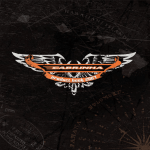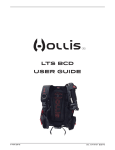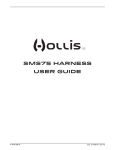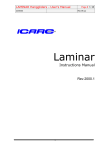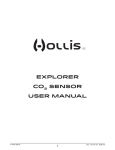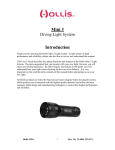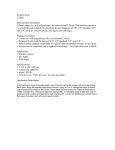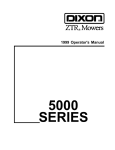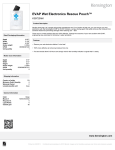Download RIDE Harness User's Guide
Transcript
RIDE Harness User’s Guide HOLLIS GEAR 2002 Davis Street, San Leandro, CA 94577 Phone: 888-383-DIVE Fax: 510-729-5115 www.hollisgear.com E-mail: [email protected] EC Type examination conducted by: SGS United Kingdom Ltd, Weston-super-Mare, BS22 6WA, UK Notified Body No: 0120’ Compliance with EN 1809:1997 Compliance with EN 250:2000 Document #12-4075 Introduction This User’s Guide describes the unique functions and features of Hollis buoyancy compensators (BC) and various optional accessories. The more acquainted that you become with your new BC, the more you will enjoy your diving experience. By following the instructions in this guide, you will understand how your BC product works, how to make best use of its features and how to ensure it is set up best for your needs. All Hollis BC’s are constructed with the highest quality materials and utilize the latest computer aided design and manufacturing techniques to ensure their highest performance and reliability. There are a number of Hollis BC systems that are designed to match your type of diving. With a selection of bladder systems and accessories, a diver can configure his or her BC system to work in any environment they are operating in. WARNINGS: □ Hollis BC’s are intended for use by divers who have successfully completed a nationally recognized course in scuba diving. □ Hollis BC’s must not be used by untrained persons who may not have knowledge of the potential risks and hazards of scuba diving □ As with all underwater life support equipment, improper use or misuse of this product can cause serious injury or death. □ Improper use of the oral Inflation/ Deflation or dump valve assemblies may allow water to enter the BC with a subsequent reduction in buoyancy. Reducing buoyancy can cause a loss of buoyancy control resulting in serious injury or death. □ Temperature conditions for use (1 to 40 degrees C) □ Limitations of dimensions of cylinders (20L single cylinder, or Twin 15 litre cylinders) □ This is not a lifejacket it does not guarantee a head up position of the wearer at the surface. □ DO NOT depend on any Hollis BC to save your life under any circumstances. □ Prior to each dive, inspect and test your BC for proper operation. If any part does not function properly, DO NOT USE! □ In an emergency, Hollis BC’s may not provide face-up flotation in all cases for all persons. □ DO NOT inhale gases from within any Hollis BC. □ On the Hollis dual bladder, the bladder against the diver’s back is the primary bladder. Do not inflate both bladders at the same time, this could decrease the overall lift provided by the bladder. Document #12-4075 □ If you do not fully understand how to use your Hollis BC, or if you have any questions regarding its functions, you should seek instruction in its use from your authorized Hollis dealer before you utilize this product. □ Read and understand the owner’s guide completely before diving with any Hollis BC. □ Have your Hollis equipment inspected and serviced annually or any time you have any concern about your equipment’s function or condition by an authorized Hollis dealer. Care and Maintenance: Your Hollis BC is a reliable piece of equipment that was designed to withstand the rigors of diving and will last for many years if cared for properly. Follow the procedures below to ensure a long life for your BC. You should have the entire BC inspected and serviced annually by an authorized Hollis dealer to ensure it is operating properly and that no components are showing signs of wear. Pre Dive Care Before each dive check to make sure your equipment is working properly. If any piece of equipment is not working properly, DO NOT USE!, and return to your authorized Hollis Dealer for repair. □ Under pressure, attach the Low Pressure Inflator Hose to the Inflator and depress the inflator button to make sure it is working properly. □ Check for leaks at connection of inflator. □ Check Oral Inflation/Deflation button is working properly. □ Fill the BC System with air and check to make sure there are no leaks in the Bladder. (Test both Bladders separately on Dual Bladder System) □ Check all dump valves to make sure air is not leaking in the closed position and that the air can be easily dumped. □ If using Integrated Weight System, make sure weight pockets are securely fastened. Post Dive Care To keep your BC in top condition, follow these procedures, in sequence, after each day of diving: □ Fill the BC one third full of fresh water through the inflator mouthpiece. □ Inflate fully, then rotate and shake, ensuring a complete internal rinse. □ Hold upside down and completely drain the water through the mouthpiece. Document #12-4075 □ Thoroughly rinse the outside of the BC with fresh water. □ Store partially inflated out of direct sunlight in a cool, dry place. □ Periodically add BC disinfectant (available in dive stores) to rinse water to kill any bacterial growth. □ Transport your BC in a padded carrying case or equipment bag, separated from sharp items (e.g., dive knife, spear gun, etc.) that might puncture the bladder. □ You should also protect the inflation system from damage from heavy objects (e.g., dive light, weights, first stage, etc.). Assessment of Risk Hollis BC’s are designed and intended for use by divers who have successfully completed a nationally recognized course in scuba diving. Hollis gear must NOT be used by untrained persons who may not have knowledge of the potential risks and hazards of scuba diving. As with all underwater life support equipment, improper use or misuse of this product can cause serious injury or death. Document #12-4075 RIDE Harness TECHnically the world’s best travel BC. It’s lightweight at just over 5lbs but packed with technical features. It includes a simple yet strong nylon harness that is one size fits most and easily adjustable. The wing is a rugged one-piece 1000 denier CorduraTM and comes in two sizes: 23lbs and 37lbs. Standard are the stainless steel 2" d-rings on the shoulders and hips, padded crotch strap, back pad and lower storage pouch. It also has the ability to dive singles or twins (depending on wing size). □ □ □ □ □ □ □ □ □ □ □ Lift capacity 23 lbs. & 37 lbs. One size fits most 1000 denier CorduraTM w/ 15 mil PU lamination - one piece Contoured, lightweight backpack w/back pad, lumbar support & storage pouch 2 shoulder SS bent D-rings, 2 lower hip SS D-rings Quick adjust shoulder and waist strap Right shoulder inflation with elbow Lower left pull dump 10lb (4.5kg) interchangeable quick release weight pockets - optional 5 lb (2.27kg) non-dumpable rear weight pockets - optional System weight: 5.5 lbs 208.1170.023 BC, RIDE, 23lbs Wing 208.1170.037 BC, RIDE, 37lbs Wing Document #12-4075 RIDE Harness (Front View) RIDE Harness Adjustment Adjustment to the RIDE harness is made by simply unthreading the shoulder straps on both the left and right sides to match. The harness comes preassembled and with enough webbing to allow a one size fits most arrangement. Document #12-4075 RIDE Harness (Rear View) Document #12-4075 Adjusting Tank Straps For the most secure tank attachment, use the following steps to weave the cam band to the buckle. Nylon may loosen when wet, so for an extra secure hold, soak the straps in water before tightening: □ Pull the band through SS attachment at the base of the buckle (Labeled 1) so the band is now on the on the outside of the buckle (Fig.1). □ Now weave the band through the middle slot (Labeled 2) from outside to inside (Fig.2). □ Now weave the band through the bottom slot (Labeled 3) of the buckle so the band is against the tank (Fig. 3 & 4). Pull band tight to make sure there is no slack around the tank or in the buckle weave (Fig.5). □ With the band tight, weave the band through the top slot (Labeled 4) of the buckle form inside to outside (Fig.6). Pull tight and fold the buckle over so it snaps against the tank (Fig.7 & 8). Now attach remaining webbing to the webbing against the tank using the attached Velcro (Fig.9). Steps in Fig.6 through Fig.9 can be done without the tank to make weaving the cam straps through the buckles easier. Make sure to leave enough slack to insert tank. Fig.1 Fig.2 Fig.3 Fig.4 Fig.5 Fig.6 Fig.7 Fig.8 Fig.9 Document #12-4075 Loading Weight Pouches and Pockets (Optional) Remove weight pouch from pocket and open flap of the weight pouch (Fig.1). Insert desired weight (up to 10lbs) into pouch (Fig.2) and secure flap of the weight pouch with the Velcro (Fig.3). Once the weight is secure on the pouch, insert weight pouch into pocket so that the buckle flap will fold outwards toward the Velcro patch. Adjust the pouch so that it fits securely in the pocket and then fold buckle flap to attach Velcro. Insert pouch buckle into the pocket buckle. Make sure it snaps into place. See Fig.4 for a view of the weight system for this harness. WARNING: The maximum weight capacity for each Weight Release Pocket is 10 pounds. Amounts that you can actually load may be less due to the type and shape of weights being used. Dropping Weight Pouches from Pocket: In an upright position, grasp the handles of both pockets (right and left) and firmly pull the pouches completely out of the pockets. Hold the pouches out so they are clear of all of your gear, and drop them. WARNING: Dropping the weights will present you with immediate positive buoyancy. Note: Practice this technique with and without weights while out of the water with the BC removed from a tank. DO NOT use the drop handles to lift or carry the pouches and store the weight pouches in a position that will not distort the curved shape (weights down or removed). WARNING: Use of the weight drop system may not afford the diver with face up flotation, especially if the weights are loaded towards the front of the pouches. Fig.1 Fig.2 Fig.3 Fig.4 Document #12-4075 Adjusting Waist Buckle & Crotch Strap Waist Cam Buckle: Insert waist cam buckle on left side webbing. See Fig.1 for recommended buckle weave. Fig.1 Crotch Strap: Opposite of looped end of the crotch strap, insert slide leaving about 8” of webbing between the slide and the end of the webbing. Then weave webbing through the larger bottom middle slot and back through slide. This is where adjustment to the crotch strap will be made. The looped end will thread onto the waist strap. Document #12-4075 Bungee Cord All of our bungeed bladders have the option of disassembling the bungee to allow adjustment or removal. First unclip the bungee from each side of the bladder on the lower inside D-rings. Remove the clip from one end of the bungee and pull bungee through the guides. It is recommended to reattach the clip to the bungee so you do not lose it. Warning: The tighter the bungee is adjusted, the less air will fill the bladder. This could pose a safety or trim issue if not properly adjusted. Important: If using this kit to mount double tanks using our doubles bands, wing bungee should be removed completely. Donning & Fitting Before any dive make sure that your BC System fits properly. With your required exposure suit on, don your BC System. Make sure it fits snugly, but is not too tight around your shoulders, waist, and crotch (when using a crotch strap). Two fingers laying flat should fit snugly between the shoulders and webbing. Make any adjustments as necessary. Adjust the D-rings and clips to your desired position. A good starting point is a position where you can reach your chest, with your hand held flat, and holding your arm and hand parallel to the ground. A properly fitted system should feel snug and comfortable. Fine tune the fit as needed. Attention: If you have any questions regarding your Hollis gear, please contact Hollis Gear and speak with one of our technical support representatives. Phone: 888.383.DIVE Email: [email protected] Document #12-4075












